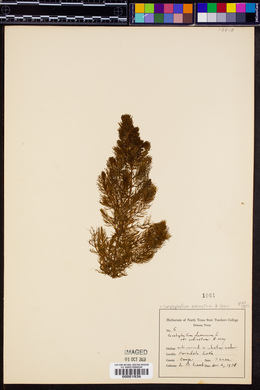Ceratophyllum echinatum
|
|
|
|
Family: Ceratophyllaceae
Spineless Hornwort, more...hornwort
[Ceratophyllum submersum var. echinatum (A. Gray) Wilmot-Dear] |
Stems to 1 m; apical leaf whorls not densely crowded. Leaves dark green or olive-green, fine-textured. Leaf blade simple or forked into 2-10 ultimate segments (forking of largest leaves 3d or 4th order), proximal segments often conspicuously inflated, mature leaf whorls 25-55 mm diam., marginal denticles weak and inconspicuous, weakly exserted, not raised on broad base of green tissue; 1st leaves of plumule forked. Achene dark green or brown, body (excluding spines) 4.5-6 × 2.5-4.5 × 1.5-3 mm, basal spines 2 (rarely absent), straight or curved, 1-5 mm, marginal spines 2-13, 0.5-6.5 mm, terminal spine straight, 1.5-7.5 mm, margins winged. 2 n = 24. Flowering spring-summer. Fresh water of lakes, ponds, marshes, swamps; 0-500 m; B.C., Man., N.B., N.S., Ont., Que.; Ala., Ark., Conn., Del., D.C., Fla., Ga., Ill., Ind., Iowa, Kans., Ky., La., Maine, Md., Mass, Mich., Minn., Miss., Mo., N.H., N.J., N.Y., N.C., Ohio, Okla., Oreg., Pa., R.I., S.C., Tenn., Tex., Vt., Va., Wash., W.Va., Wis. Principally an eastern North American species--and the only species of its genus endemic to North America-- Ceratophyllum echinatum is disjunct in the Pacific Northwest as a result of repeated Pleistocene glaciation. The habitats of C . echinatum are typically more acidic (avg. pH 6.6) than those of C . demersum (avg. pH 7.4). The two species only rarely coexist. Ceratophyllum echinatum also thrives in cooler, clearer, and more oligotrophic water than C . demersum and often is found in more ephemeral sites, such as shrub swamps (e.g., with Cephalanthus occidentalis ) and beaver ponds. This species, relatively uncommon, is fast disappearing from much of its range because of habitat alteration or destruction and the introduction of nonindigenous species; steps should be taken to secure its conservation. Unlike Ceratophyllum demersum , C . echinatum does not attain status as a serious weed.
Perennial submersed aquatic herb to 1 m tall Stem: branched, free-floating or buried in substrate, lacking roots. Leaves: whorled, stalkless or nearly so, dark to olive green, whorls 2.5 - 5.5 cm across, forking three to four times into narrow segments that are close to the stem and often conspicuously inflated, not distinctly toothed, not crowded toward tip, fine-textured. The first seedling leaves are divided at least once. Flowers: either male or female, found on the same plant (monoecious), borne in leaf axils, with leaf-like bracts fused at the base but lacking sepals and petals. Male flowers have two-chambered anthers, and female flowers have a single ovary tapering to a persistent spine-like style. Fruit: a one-seeded elliptic achene, dark green to brown, warty with winged margins, two straight or curved basal spines (1 - 5 mm long), several marginal spines (0.5 - 6.5 mm long) and one straight terminal spine (1.5 - 7.5 mm). Similar species: The similar Ceratophyllum demersum has coarse-textured leaves that are crowded toward the tip, fork only once or twice, and are distinctly toothed. The fruit is unwinged with two basal and one terminal spine. Flowering: July to September Habitat and ecology: Rare, usually found in acidic softwater lakes and ponds. Occurence in the Chicago region: native Notes: Habitat change or destruction and non-native plant introductions are leading to the disappearance of this species. Etymology: Ceratophyllum comes from the Greek words keras, meaning horn, and phyllon, meaning leaf, referring to the horned appearance of the leaves. Echinatum means "covered with prickles." Author: The Morton Arboretum Much like no. 1 [Ceratophyllum demersum L.]; lvs more flaccid, the larger ones mostly 3(4) times forked, the ultimate segments commonly narrower, entire or with a few small, very slender teeth; achenes with several unequal marginal spines as well as 2 basal ones, conspicuously tuberculate on the surface; all plumular lvs forked. Quiet water; N.S. and N.B. to B.C., s. to Fla. and trop. Amer.; less often collected than no. 1. Gleason, Henry A. & Cronquist, Arthur J. 1991. Manual of vascular plants of northeastern United States and adjacent Canada. lxxv + 910 pp. ©The New York Botanical Garden. All rights reserved. Used by permission. |






















































































